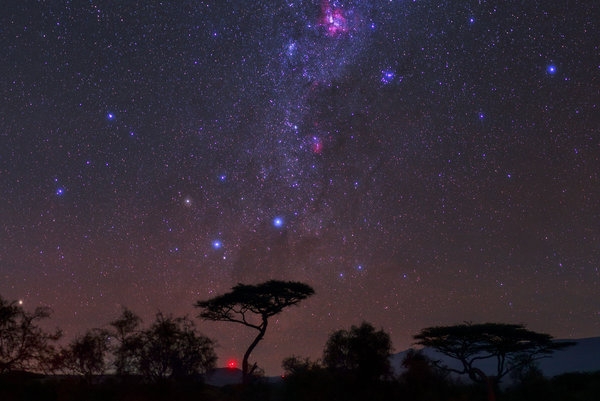
The Southern Cross, Milky Way, Large Magellanic Cloud and Carina Nebula, viewed from Kenya. Credit: Babak Tafreshi/National Geographic Society, via Corbis
Stargazing is better on the Southern Hemisphere
The New York Times
28 December 2014
by Vanessa Barbara
Contributing op-ed writer
SÃO PAULO, Brazil — EARLIER this year, I visited Fernando de Noronha, an island off the northeastern coast of Brazil, only four degrees south of the Equator. When I was walking to a restaurant, I noticed something strange in the night sky: It was Ursa Major, the constellation that Americans call the Big Dipper and the British call the Plough.
The Big Dipper, commonplace in the north, is rarely seen in the Southern Hemisphere, though a friend of mine swears he saw it once from the top of a mountain in São Paulo. According to him, it was just above the horizon.
I’m jealous of those who have the Big Dipper. I also envy those who get to see the Northern Lights, which I saw recently during a trip to Iceland.
But that’s all.
The Dutch-American astronomer Bart Bok used to say: “The Southern Hemisphere holds all the good stuff.” He was probably referring to the fact that we have “the two best globular clusters, the largest and brightest naked-eye external galaxies, the largest diffuse nebula, the largest dark nebula and a Milky Way bright enough under our dark transparent skies to cast shadows during certain times of the year,” in the words of the journalist Luke Dodd.
Here the central parts of the Milky Way are at times directly overhead, visible from horizon to horizon, like an open, brilliant bruise. Here we also have an exclusive look at two of our neighboring galaxies, the Small and Large Magellanic Clouds. They both have a declination — the astronomical measurement of the distance from the celestial equator — of close to 70 degrees south and are circumpolar, which means that they are mostly visible only from this half of the planet. (A high-five to the third world!)
It is true that, as well as Ursa Major, northerners have the constellation Cassiopeia and Vega, the fifth-brightest star in the night sky. Vega has been used as the baseline for the apparent magnitude scale, which describes the brightness of stars, and to calibrate telescopes.
Yet the Southern Hemisphere claims the three brightest stars of the night sky: Sirius, Canopus and Alpha Centauri. Canopus belongs to the Carina constellation, notorious for two things: the Carina Nebula, four times as large and even brighter than the famous Orion Nebula, and the star system Eta Carinae, which is expected to burst as a supernova or hypernova sometime in the next thousand years. (A scientist told the BBC that the explosion would be so bright that you would see it during the day, and you could even read a book by its light at night.) Alpha Centauri and Beta Centauri, the 11th-brightest star, are called “The Pointers,” as they form a line in the sky to the constellation Crux (the Southern Cross). Crux is the smallest of all 88 constellations but one of the most distinctive. It is visible at practically any time of the year in all of the Southern Hemisphere.
Along the eastern edge of Crux is the Coalsack Nebula, a deep dark patch where stars are born. Near the Coalsack is the Jewel Box, a cluster of roughly 100 stars colored red, white and blue, and visible with a pair of binoculars. There’s also Omega Centauri, the largest and brightest globular cluster in the sky, with its topaz, orange and red stars.
Constellations like Sagittarius and Scorpius are best seen in the Southern Hemisphere; the latter lies within the center of the Milky Way, high in São Paulo’s sky. It is possible to see the scorpion from its sting to its claws, including the red supergiant star Antares at its heart.
Professor Neville H. Fletcher, now an emeritus professor at Australian National University, once said: “In astronomy circles it is often remarked — mostly by envious northerners — that God, in creating the universe, perversely located all the most interesting regions of our galaxy in the Southern Hemisphere, but all the astronomers in the north.” As a result, it can be more difficult down here to pick out the shapes for which the constellations were originally named.
The classic example: Orion, the hunter, is not proudly standing on his feet, but rather doing a cartwheel. Also, the brave lion from the constellation Leo looks more like an upside-down turtle. Or maybe a magical lamp. The twins of Gemini are falling to the ground. Boötes, the plowman, and the dog from Canis Major are both tripping. So more creativity is required of us South Americans, Africans, Australians, New Zealanders and other lucky inhabitants of the Southern Hemisphere.
There’s a quote attributed to Mr. Bok, who left Harvard in the ’50s for Australia but often lectured to members of the Royal Astronomical Society in London, that sums it up nicely: “Gentlemen, you live under the wrong half of the sky!”

